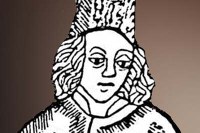Mondino introduced the revolutionary practice of autopsy as part of the empirical teaching of medicine. This allowed the discipline to gradually free itself from the theories of the ancients, moving towards a modern conception of knowledge.
 Mondino de’ Liuzzi was born in about 1275 in Bologna. His family, originally from Florence (it was probably his grandfather who first moved to Bologna), was a member of the Società dei Toschi and had belonged to the Guild of Physicians and Apothecaries for multiple generations.
Mondino de’ Liuzzi was born in about 1275 in Bologna. His family, originally from Florence (it was probably his grandfather who first moved to Bologna), was a member of the Società dei Toschi and had belonged to the Guild of Physicians and Apothecaries for multiple generations.
While his father, Raniero, had chosen to continue the business activity of his grandfather Albizio, Mondino was soon taken under the wing of his uncle Liuzzo, a physician of some renown and university professor.
The young man then studied at the prestigious school of Taddeo Alderotti, taking a degree in medicine in 1292.
With his uncle, he began to practice and teach medicine at his home, in the Porta Stiera quarter (now via Ugo Bassi), where, like many other teachers, he also housed some of his students.
It is not known when exactly he began teaching at the university, but it is likely that he was already a professor of medicine and teacher of logic by the early 14th century. Indeed, when he got involved in a brawl in 1311, he was immediately acquitted due to his status as a “privileged person”, presumably because a professor.
Mondino’s fame is primarily tied to the innovative discipline of anatomic dissection, which he was the first to methodically pair with the study of classical texts.
The first documented autopsy had been carried out by the Hellenistic School of Alexandria in the 3rd century BCE, but its use as an empirical research tool was forbidden by subsequent Roman and medieval laws, for more than 1500 years.
In the late Middle Ages, modern international medical schools, first and foremost the one in Salerno, were still working solely on animal carcasses (for the most part, pigs), but Bologna was ahead of its time here, as well. In 1265, the podestà had established a body of physicians in charge of vulneratum, the investigation of fatal wounds on cadavers. This task proved to be useful and was added to the practical lessons given by the physicians of the time, such that the basic concepts of autopsy were already broadly known to Mondino’s predecessors: Taddeo Alderotti, Gugliemo da Saliceto and Bartolomeo da Varignana.
It was on the initiative of Liuzzi, however, that dissection finally became considered indispensable to teaching, regulated by university statutes and provided for in those of the city.
Thanks to the Bolognese physician, direct observation retook its legitimate place in the study of the human body, remaining, however, secondary to the theories found in classical texts, which were in turn finally being questioned again, on the basis of the truths revealed by the body to the eyes of specialists.
Mondino’s research was fundamental for the subsequent generations of physicians and anatomists, who, thanks to their own teachers, Mondino’s students (one of whom Guy de Chuailac, considered the father of French anatomy), were able to advance medicine to a new scientific and technical plane.
His treatise Anathomia (1316) was used by every medical school in Europe until the second half of the 16th century. A true dissection manual, it was the first in which astrological notions were absent and man and the nature of his body were placed at the heart of the discussion.
Besides Anathomia, other texts by Mondino in circulation included his Commenti on Hippocrates, Galen, Avicenna and other classical and Islamic physicians, the Consilia, on a few specific diseases and their cures, and the Quaestiones, the most famous of which being the Utrum corpus sanum ut nunc habeat sanitatem acquisitam a rebus temporalibus, sive a tempore, vel ipsam habeat a generatione (1312).
The complex post-mortem procedure, as illustrated in numerous miniatures from the time, entailed the division of tasks: the reader read and commented on the written text while the presenter pointed out the parts of the body on the cadaver (which was usually used for four lectures), having been opened up by the dissector’s scalpel.
An image of this process in a 15th-century edition of Liuzzi’s text caught the imagination of the Bolognese historian Alessandro Macchiavelli in 1739. The dissector with long hair working under the watchful eye of the professor is falsely passed off by Macchiavelli as Alessandra Giliani da Persiceto, the wife of one of Liuzzi’s assistants and in turn a practising follower. This story, supported by fake sources, was probably a success and was held to be credible for more than two centuries, because it was recounted at the time by Laura Bassi, the first woman to hold a modern professorship. There were, for that matter, far better-known medieval precedents, the wives, sisters and daughters of distinguished professors having actually taught at the University of Bologna.
A portrait of Liuzzi, along with engravings and prints from his treatises, can be seen in the 17th-century Anatomical Theatre of the Archiginnasio, alongside wooden statues of other leading figures from the history of medicine, as well as under the arcade of the church of San Vitale e Agricola. Mondino commissioned a fitting tomb for his beloved uncle in the same church, where he was buried as well in 1326. On the tomb slab, he is portrayed teaching his students: common iconography in 14th- and 15th-century Bologna, where professors were remembered for their teaching gifts by the entire city even after their deaths.
